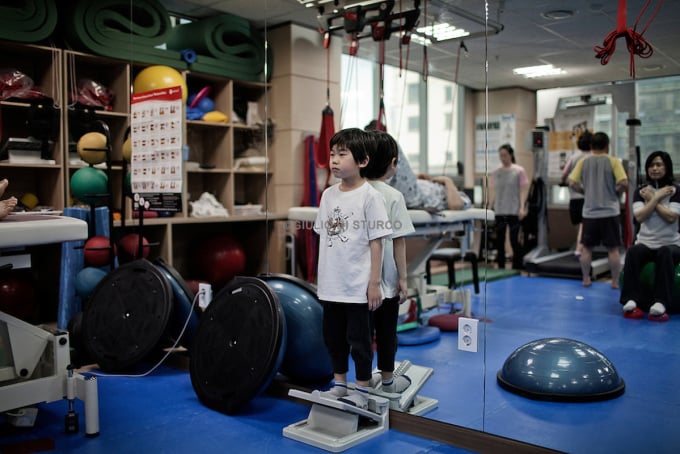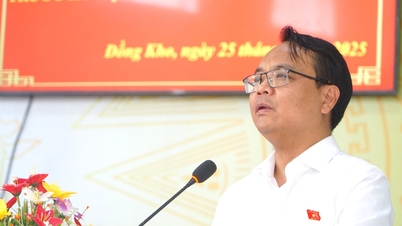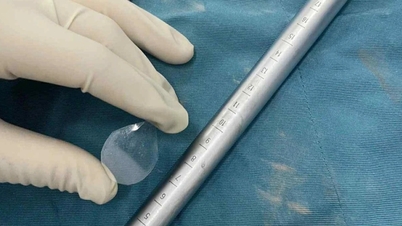To help their children grow a few centimeters taller, many Korean parents spend millions of won on growth hormone injections or leg lengthening surgery.
For a long time, parents in South Korea have invested tens of millions of won to help their children grow taller. The measures include vitamin supplements, herbal medicine, growth hormone injections, acupuncture, and even surgery. As a result, the height of the country's population has increased at a phenomenal rate compared to other countries in the past century. According to research by Imperial College London, South Korean women grew 20.2 cm and men grew 15.2 cm from 1914 to 2014, while the global average increase in the same period was 7.62 cm.
The average height of South Korean women is now 1.59 m, while that of men is 1.72 m, according to the Ministry of Trade, Industry and Energy. The country's rapid growth is linked to nutrition and the relentless efforts of many people to become taller.
According to the Institute of Drug Research (IQVIA), the Korean growth hormone market has nearly doubled in four years, from 126.2 billion won (US$96.1 million) in 2018 to 237.2 billion won (over US$190 million) in 2022. According to a report by the Ministry of Food and Drug Safety, sales of height-related functional foods have increased 10-fold over the same period.
The desire to increase height is not only in Korea, however in this country, it has become an obsession.
Set height goals for your child from an early age
According to the Health Insurance Assessment Service, more than 43,000 South Korean children visited hospitals for height problems in 2021.
"My second son is not short, but not tall either. So I want to go to a clinic and treat him with growth hormone if possible. As a parent, I feel responsible for helping my son succeed," said a mother of two surnamed Noh.
Lee Hyun-su, another parent who came to the clinic with her 9-year-old son, said children grow taller in a very short period of time. She wanted to “do whatever it takes” to make her son taller. According to her, her son is about 2 centimeters shorter than average.
It is estimated that parents spend about 10 million won a year to inject growth hormones into their children. This method lasts about 5 to 6 years. Health insurance only covers children whose height is in the bottom 3% for their age, children who are diagnosed with growth hormone deficiency or growth disorders.
Hong, a 10th grader, said she had been taking hormone injections against her family’s wishes from the age of 10 to 15. Born slightly underweight, Hong is now 1.71 m tall, just 1 cm shorter than the national average.
Kim, a mother living in Australia, takes her two sons to South Korea every year for hormone injections. Her two sons have idiopathic dwarfism, a medically benign condition that is not classified as a growth hormone disorder. She understands the side effects, such as high blood pressure and joint pain, of taking hormones, but is willing to make the trade-off, as her first child has grown about 10 centimeters a year since starting the injections in 2019.

Children at height growth centers in Korea. Photo: Giulio Studio
Social discrimination against short people
In a 2016 poll, more than 50% of 500 respondents said that height is an important part of life. 38% said that their ideal height makes them more confident, 27% said that height is a factor in their social acceptance, and 20% pointed out that taller people are more likely to date.
For the past two decades, tall stature has been considered the standard. K-pop idols have grown taller every year. It is estimated that the average height of girl groups that debuted last year was 1.66m, while boy groups were 1.77m.
Social prejudice against height was openly acknowledged in South Korea in 2009, when a female guest on a KBS TV show brazenly called all men under 1.8m "losers." The incident caused outrage, with more than 200 people filing a lawsuit demanding 4 billion won in damages from KBS.
On many forums, men shorter than 1.72m are called kijaknam, a derogatory term for people with small stature. "I have been rejected many times for dates because of my height," said one user.
According to a marriage counseling agency employee in Gayeon, height is a top priority for many clients. They set very specific standards. Men want their girlfriends to be around 1.6m tall, while women want their boyfriends to be at least 1.7m tall.
Last resort: leg lengthening surgery
Social pressure has led many to resort to the riskier procedure of leg-lengthening surgery, in which the surgeon breaks both thigh bones and inserts rods and screws into the legs to increase the patient’s height.
"In the worst case, the patient may not be able to walk again," said Lee Dong-hoon, a surgeon and director of the Donghoon Advanced Lengthening Reconstruction Institute orthopedic clinic in Seongnam.
Performing about 300 leg-lengthening surgeries a year, Lee said 90 percent of his patients are men in their 20s.
"Most of them are around 1.6m tall, but I've also met people who are as tall as 1.8m. They want to be models, and to be a model you need to be another 6 or 7cm taller," he said.
Leg-lengthening surgery costs between 40 million won and 80 million won, and takes several months to fully recover. First, the surgeon breaks the tibia and fibula—the two longest bones in each leg. Then, they hollow out each tibia, removing enough marrow to insert a metal rod, called a “needle.” Next, they make several incisions around each leg and insert pins into each central needle to secure it.
Two months after the surgery, the patient was confined to a wheelchair. During that time, they needed to use a wrench four times a day to turn the pins, which were inserted into the legs to lengthen the metal rods. This separated the broken pieces of bone, allowing the body to regrow bone to fill in the gaps, lengthening the legs.
"I call it life-changing surgery. It can go very badly, but once it works, it really changes your life," said Dr. Lee.

Illustration of surgical instruments. Photo: Pexel
Is the pain worth it?
According to Lim In-sook, a sociology professor at Korea University, physical beauty is considered by South Koreans as an achievable goal if enough effort, time and money are put in.
“Companies post before and after plastic surgery pictures on billboards, making people more aware of their body flaws. All of this leads to the desire to get surgery and become beautiful,” he said.
However, Dr. Lee believes that cosmetic surgery can also be a psychological treatment for people who are stressed about their body image.
"In my experience, no matter how much advice and comfort they receive, their depression does not go away. For people who are stressed about their dwarfism, surgery can be a clear cure," he said.
However, he also affirmed that leg lengthening is a dangerous surgery with unpredictable side effects and requires a long recovery time.
Thuc Linh (According to Korea Joongang Daily )
Source link



![[Photo] Hanoi morning of October 1: Prolonged flooding, people wade to work](https://vphoto.vietnam.vn/thumb/1200x675/vietnam/resource/IMAGE/2025/10/1/189be28938e3493fa26b2938efa2059e)

![[Photo] President of the Cuban National Assembly visits President Ho Chi Minh's Mausoleum](https://vphoto.vietnam.vn/thumb/1200x675/vietnam/resource/IMAGE/2025/10/1/39f1142310fc4dae9e3de4fcc9ac2ed0)

![[Photo] Keep your warehouse safe in all situations](https://vphoto.vietnam.vn/thumb/1200x675/vietnam/resource/IMAGE/2025/10/1/3eb4eceafe68497989865e7faa4e4d0e)




























































































Comment (0)